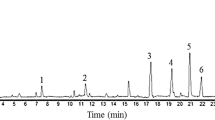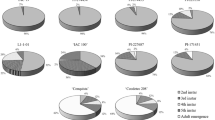Abstract
Leaf extractables/fractions obtained from the leaves of soybean PI 227687 showed greater antifeedant activity towards the third-instar larvae of the cabbage looper, Trichoplusia ni (Hub.). Extraction of leaves with ethyl acetate followed by 60% methanol, and counter-current partitioning of leaf extractables between ethyl acetate, water and hexane was not convenient for isolation of antifeedants. Methanol (60%) in water extracted most of the antifeedants from leaves, and this extract when partitioned between ethyl acetate and water (the latter repeatedly extracted with the former), concentrated the antifeedants from soybean leaves for further processing on thin layer chromatography or high performance liquid chromatography.
There were quantitative differences in ethyl acetate fraction of PI 227687 (6%) and Davis (3.2%), and in flavonoids resolved at Rf 0.10–0.20 in benzene: ethyl acetate: methanol (4:3:3). Most of the flavonoids with antifeedant activity resolved at Rf 0.10–0.80. The antifeedant activity of flavonoid bands from PI 227687 was greater than the corresponding bands of Davis.
Résumé
Les extraits ou fractions foliaires obtenus à partir des feuilles de PI 227687 ont montré une activité phagodissuasive élevée sur les larves du troisiéme stad de l’arpenteuse du chou, Trichoplusia ni (Hub.). L’extraction des feuilles effectuée avec l’acétate d’éthyle suivie du méthanol à 60%, et la séparation à contre-courant des extraits foliaires entre l’acétate d’éthyle, l’eau et l’hexane n’ont pas facilité l’isolement des phagodissuadents. Le méthanol (60%) dans l’eau a permis d’extraire la plupart des phagodissuadants àpartir des feuilles. Séparé entre l’acétate d’éthyle et l’eau (la fraction aqueuse se séparé à plusieurs reprises de celle d’acétate d’éthyle) cet extrait a permis de concentrer les phagodissuadants à partir des feuilles de soja pour un deuxiéme traitement par la chromatographie sur couchemince ou la chromatographie liquide à haute performance.
On a constaté des différences quantitatives dans la fraction d’acétate d’éthyle de PI 227687 (6%) et celle de Davis (3,2%), ainsi que dans les flavonoïdes résolus entre Rf 0,10 et 0,20 dans le système benzène: acétate d’éthyle: méthanol (4:3:3). La plupart des flavonoïdes ayant une activitéphagodissuasive se sont résolus à Rf 0,10–0,80. De plus, l’activité phagodissuasive des bands de flavonoïds de PI 227687 était plus élevée que les bands correspondantes de Davis.
Similar content being viewed by others
References
Caballero P. and Smith C. M. (1986) Isoflavones from an insect resistant variety of soybean and the molecular structure of afromosin. J. Nat. Prod. 49: 1126–1129.
Chiang H. S., Norris D. M., Ciepiela A., Oosterwyk A. and Jackson M. (1986) Comparative constitutive resistance in soybean lines to Mexican bean beetle. Entomol. exp. appl. 42: 19–26.
Chiang H. S., Norris D. M., Ciepiela A., Shapiro P. and Oosterwyk A. (1987) Inducible versus constitutive PI 227687 soybean resistance to Mexican bean beetle, Epilachna varivestis. J. Chem. Ecol. 13, 243–275.
Ebel J. (1986) Phytoalexin synthesis: The biochemical analysis of the induction process. Annu. Rev. Phytopathol. 24: 235–264.
Fehr W. R., Caviness C. E., Burmood D. T. and Pennington J. S. (1971) Stage of development descriptions for soybean, Glycine max (L.) Merrill. Crop Sci. 11: 929–931.
Hart S. V., Kogan M. and Paxton J. D. (1983) Effect of soybean phytoalexins on the herbivorous insects Mexican bean beetle and soybean looper. J. Chem. Ecol. 6: 657–672.
Ingham J. L., Keen N. T., Mulheirn L. J., and Lyne R. L. (1981) Inducibly formed isoflavonoids from leaves of soybean. Phytochem. 20: 795–798.
Keen N. T. and Paxton J. D. (1975) Coordinate production of hydroxyphaseollin and the yellow fluorescent compound PAK in soybeans resistant to Phytopthora megasperma var. sojae. Phytopath. 65: 635–637.
Keen N. T., Zaki A. I. and Sims J. J. (1972) Biosynthesis of hydroxyphaseollin and related isoflavonoids in disease resistant soybean hypocotyls. Phytochem. 11: 1031–1039.
Khan Z. R., Norris D. M., Chiang H. S., Weiss N. E. and Oosterwyk A. S. (1986) Light-induced susceptibility in soybean to cabbage looper, Trichoplusia ni (Lepidoptera: Noctuidae). Environ. Entomol. 15: 803–808.
Leudders V. D. and Dickerson W. A. (1977) Resistance of selected soybean genotypes and segregating populations to cabbage looper feeding. Crop Sci. 17: 395–397.
Markham K. R. (1975) Isolation techniques for flavonoids. In The Flavonoids (Edited by Harborne J. B., Mabry T. J. and Mabry H.). Academic Press, New York.
Sharma H. C. and Norris D. M. (1991a) Chemical basis of resistance in soybean to cabbage looper, Trichoplusia ni. J. Sci. Food Agric. 55: 353–364.
Sharma H. C. and Norris D. M. (1991b) Comparative feeding preference and food intake and utilization by the cabbage looper (Lepidoptera:Noctuidae) on three legumes. Environ. Entomol. 20: 1589–1594.
Shorey H. H. and Hale R. L. (1965) Mass rearing of the larvae of nine noctuid species on a simple artificial medium. J. Econ. Entomol. 58: 522–524.
Smith C. M. and Fischer N. H. (1983) Chemical factors of an insect resistant soybean genotype affecting growth and survival of the soybean looper. Entomol. exp. appl. 33: 343–345.
Smith C. M., Brim C. A. and Wilson R. F. (1979) Feeding behaviour of Mexican bean beetle on leaf extracts of resistant and susceptible soybean genotypes. J. Econ. Entomol. 72: 374–377.
Author information
Authors and Affiliations
Rights and permissions
About this article
Cite this article
Sharma, H.C., Norris, D.M. Biochemical Mechanisms of Resistance to Insects in Soybean: Extraction and Fractionation of Antifeedants. Int J Trop Insect Sci 15, 31–38 (1994). https://doi.org/10.1017/S1742758400016738
Received:
Accepted:
Published:
Issue Date:
DOI: https://doi.org/10.1017/S1742758400016738




